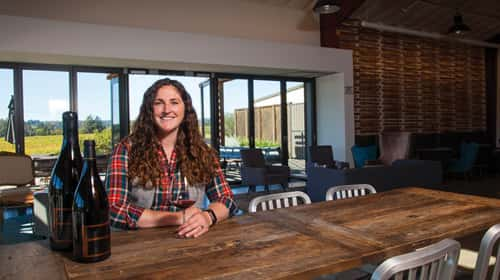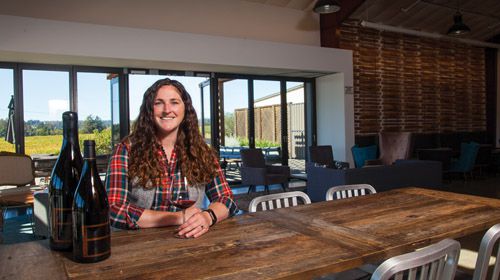
The story of Mari Jones and Emeritus Vineyards begins long before she was born. It began during the Vietnam War, when a general introduced Brice Jones, a young Air Force fighter pilot, to a fine French red wine. Brice, like most Americans, believed good red wine was bottled by the jug. The general had been introduced to fine French wine when his plane was shot down during World War II, and he shared his passion for French wines with young Brice.
Years later, the taste of that wine launched Brice Jones into a career in the wine industry and two notable vineyards, Sonoma-Cutrer and Emeritus. The path that eventually led to Emeritus Vineyards, says Brice, seemed to be blessed by events falling into place at the right place and right time—paved by providence.
The early years
 In 1972, in pursuit of creating a great red wine like the one the general had introduced him to, the young pilot, fresh from Harvard University with a Master of Business Administration in hand, purchased a vineyard with the intent to make a great French red wine and giving investors a tax write-off. He was 32 years old.
In 1972, in pursuit of creating a great red wine like the one the general had introduced him to, the young pilot, fresh from Harvard University with a Master of Business Administration in hand, purchased a vineyard with the intent to make a great French red wine and giving investors a tax write-off. He was 32 years old.
By chance, the only land available, Hallberg Ranch, was suitable for a different varietal he’d never heard of—Chardonnay. Nevertheless, he bought the land, developed the vineyard and proceeded to make one of California’s great Chardonnays. By 1999, his new Sonoma-Cutrer Vineyard and Winery was finally making money—the brand had become famous and Jones was ready to pursue a new challenge. He’d never lost his taste for a fine red wine, and he knew where he could grow it, but the problem was it was a 115-acre thriving apple orchard at the time. Then in 1999, by a singular stroke of luck, or perhaps destiny, the orchard became available. The owners, Don and Marcia Hallberg, were ready to sell Hallberg Ranch. Jones named the winery, Emeritus, acknowledging the depth of experience he and his associates brought, along with their dedication to making the best Pinot Noir.
Running roughly 10 miles from southeast of Sebastopol to Forestville in the heart of the Russian River Valley, is The Gold Ridge, a geological formation named for the color and agricultural quality of its soil. Here, the loamy soil and mild weather—a little cooler, with just enough fog and afternoon sun—was perfect for growing Pinot Noir.
During his career, Brice married and had three children, including two sons, Victor and Monte as well as a daughter, Mari.
In his early years with Sonoma-Cutrer, Brice had tuned his taste to the French, learning what makes great wine and puzzling over terroir— the complete natural environment in which a particular wine is produced, including factors such as the soil, topography and climate. On a trip to France, he took his daughter, Mari, who was 12 years old at the time, was allowed to taste in the cellars with her father. The story she often tells is that after one particular sip of red Burgundy, she turned to her father and said, “You need to make a wine this good.”
Today, Mari laughs at the memory. “He must’ve thought he’d created a monster,” she says. What young Mari was tasting, she would learn years later, was terroir. The moment foreshadowed her role as a key adviser in the business of her father.
Changing with the times
If the wine business began to waken and stretch in the 1970s, by the turn of the 21st Century it was a whole new scene. “Between ’99 and now, the change has been exponential,” says Brice. He explains that the curve broke in 2008 with the financial crash, from which the restaurant business (where he’d sold his wine) has still not fully recovered. As a result, the restaurants started to lean on alcohol sales, pushing the prices up to where customers begin to resist. “It used to be $65 to $70 for a bottle,” he says. “Now it’s $125.” Across the industry, it was obvious that something had to change in the way wineries marketed wines.
A new generation
In 2012, when Emeritus was searching for solutions, Brice called Mari. His sons, Victor and Monte, had been involved with the business, but were following their own passion in Monterey County where they planted apples and fruit trees and founded Mission Trail, a thriving cider business. Neither son was inclined to take on the growing needs of Emeritus. With their father’s blessing, they founded Mission Trail Cider.
Mari, fresh from college, had been living in Telluride, Colo., skiing and working for a nonprofit helping bring outdoor recreation into the lives of people of all abilities. She loves the mountains, but also California and her father’s beautiful wines. So, when Brice invited her to move to Sonoma and help him, she agreed. She was 25 and hadn’t considered going into the wine business, but since he asked, it seemed a natural step to take. She was dating Brian Rooney at the time, and he was enthusiastic about the opportunity. Later, they would marry in 2016.
Together, they left the mountains and Mari settled into work at Emeritus. Initially, she didn’t lay out a vision for her father for bringing Emeritus into the 21st Century. She knew to proceed slowly. She was learning and was confident. She kept an eye on the business, while creating strategies to enhance it. With her new insight, she was interested in building a tasting room, giving tours and making new wines. Knowing her father, she offered her suggestions and launched her ideas incrementally, knowing she could impact change. “I knew with time, hard work and results, I could make the changes that needed to be made.”
Brice was in awe at how his daughter met the challenges of the times. “Organizations need youth,” he says, recalling his own early days in the business.
A new marketing vision
The Emeritus vineyards and wines had already gained a notable reputation in the industry, so Mari was mostly compelled to make changes to their marketing efforts. At the time, most sales were through wholesale distribution. But, as Brice says, times were changing. Mari advised her father to bring Emeritus into the world of online marketing, to have an e-commerce website and tasting room to draw people in. Her father obliged and brought in consultants to advise them.
“They [consultants] made copious notes,” he says. “They debriefed Mari, and she thanked them for the help, and eventually ignored every one of their suggestions,” recalls Brice, sitting in his dusty farmer’s jeans. He gestures around the airy, open room and says, “She built this!” The tasting room, decorated in muted colors, offers sweeping vineyard views through vast windows. His love for his vineyard and pride for his daughter and her work is barely contained. “Look at this tasting room!” he says. “Last year, USA Today ran a survey on tours and tasting rooms in America and we were number one of 20.” He points out that, unlike most tasting rooms, there is no bar. Instead, there’s a long communal table for casual group tastings, or you can sit in luxurious comfort privately with your host as you sample the wines, enjoy the room, and gaze at the vineyard just outside the windows.
Mari has decorated an entire wall of the tasting room in a pattern of staves from used barrels. Every year her father or the winemaker travels to France to pick out the trees that will be made into barrels. “I don’t know of any other American winery that does that,” she says. “But we go, with our forester, and buy our own trees. We go right to the point of origin, so we can see what we’re getting—in the spring, when the sap is going down. We have the forester age the staves in his yard for three years, according to our instructions as to how high we want them stacked and how often we want them rotated and turned, to make sure everything is getting seasoned, and that they’re aged for three years.”
A collaborative process
Currently, Mari is working with winemaker David Lattin and vineyard manager Kirk Lokka to hone in on areas of the vineyard they believe are creating special wines and bottling them separately. She works closely with the Emeritus direct-to-consumer and wholesale business to make sure all they’re doing is dynamic and innovating.
“We have just bottled a white Pinot Noir,” she says. “It’s the first time I’ve ever done it.” For Mari and Lattin, it’s an experiment. They wanted to produce a wine that was unique. “We have this wine, which is naturally white after being de-stemmed, and we wondered what to do with it.” Mari and Lattin fermented the wine to see what would happen. “So, we have it fermented, and it’s amazing!” We then create some texture with it; let’s put it into barrels; let’s leave it on the lees and do some battonage.’” (Battonage is French for stirring the sediment of winemaking back into the wine. It’s a way of enhancing flavor.)
The process was a collaborative venture as they experimented with the wine. Mari acknowledges that she doesn’t have winemaking expertise, but she has a palate cultivated since the age of 12, an instinct for the business, a team and a winemaker she trusts, so the creative process works. This fall, Emeritus will release this new wine, Hallberg Blanc, to club members.
The winery will also release a 2017 vintage with three new wines that they’ve never bottled before—all single-block and single-clone wines. “It’s that whole process of tasting through each barrel with our winemaker and our winemaking team and identifying that yes, these are special wines and also they’re different.” By “different,” she explains that while any wine can be different from others, what they’re after is “special,” but all within the range of Pinot Noir. “That’s all that we do,” she says. With 140 acres in total, and 11 different clones, they sell 65 percent of their grapes to other producers, leaving plenty of opportunity to create additional special wines such as La Combette, one of Mari’s single block bottlings. “[It’s] a beautiful intense rich wine, which we love.”
An instinct for the business
Since joining Emeritus nearly six years ago, Mari has built a wine club, designed a new tasting room, developed wine tours, events, added winemaking dinners and continues the tradition of making great, and innovative wines. She’s also initiated organizational practices that improve and foster communication among the various departments of the business and increase a feeling of cohesiveness by facilitating more cross-communication and collaboration among departments. It’s difficult sometimes to meet every week, she says, but it keeps everyone engaged and involved.
If there’s a secret to her success, it may well be her vision and personal touch. “My favorite thing is sharing our wine with people, and sharing our stories,” she says. “And making sure our business is sustainable, and from the environmental side as well. It’s important that we are stewards of our land, our vines and our people.” For Mari, Emeritus feels like a big family. “I’ve known at least 10 of the people of Emeritus my whole life,” she says. “And it feels like I’ve known everyone else my whole life.” She takes her responsibility as chief operating officer for caring that all the employees have their stable jobs, healthcare, and that the business remains healthy.
As for working with her dad, she pauses to smile, then says, “He’s larger than life. He’s so passionate about what we’re doing, and the wines we’re making. He’s unwavering in his commitment to quality, and it’s just fun to learn from him in that way.” The admiration seems to be mutual. “She’s going to be CEO,” says Brice. “Everybody in the company has been saying, ‘Push her up. Give her authority.’ That’s the only way it works—if the people want her. She’s capable.”
Today’s industry
What’s interesting about the wine industry, Mari notes, is that while all of the experimentation, from the management of the vines to the experimenting process is done within the same 12-month period, the result isn’t known for years. “I have a lot of friends who work in tech and they’re rolling out new products weeks after they conceive them. But for us, we conceive a new product that won’t sell for three or four years.”
While Brice is still very much involved in the business, it’s clear that Mari, chief operating officer, is starting to lead the way at Emeritus Vineyards. On this late summer day, a man walks through the glass door entrance with his wife at his elbow. “Is this where I can buy Emeritus wine?” he asks. Mari excuses herself and greets the man who describes a dinner party he attended for a friend in Alexandria, Va., who was promoted to Colonel, and where they served this gorgeous, unforgettable wine called Emeritus. Was he at the right place? He was indeed.
Emeritus & the Search for the True Terroir
Brice Jones learned about terroir from Aubert de Villaine, one of the great leaders of taste in Burgundy, France. The awakening moment came one day when he was talking to de Villaine about plans for his new coastal vineyard and Jones mentioned that he’d not yet put in the irrigation. At this, the French tastemaker exclaimed in Gallic horror, “Mon Dieu! Non, non, non! If you put irrigation in, you will change the signature of the wine!”
“’Change the signature of the wine,’" says Jones, wonderingly. "What on earth did that mean?” He pauses, frowning. “I thought about that for two years, then I got it." With a drip-irrigated vine, he learned, the water collects in what they call an “onion,” a ball about 18 inches around and deep, where the roots collect into a mass over the years, drinking the constant water. Contrast this with a vine that has to search for water and sends its roots deep down into the soil and branching wide as it goes. The result would be like the difference between a hydroponic tomato and one grown in the garden. Fired up with a desire for true terroir, he approached his long-time vineyard manager, Kirk Lokka, and said, “Kirk, I think we ought to dry farm." Kirk, knowing that however they might farm grapes without irrigation in France, in the summers, France gets rain. So he said, "You know we can’t do that!”
From vines to apples to vines?
At that point in the story, the farmer, as Jones likes to call himself, leans forward as if to tell you a secret. “The Hallberg Ranch, before it became a vineyard, was an apple orchard and had been so since Prohibition. “But before Prohibition, it was a vineyard!” He explains that during Prohibition, people couldn’t grow grapes, so they put in apples. “But, they didn’t irrigate before Prohibition!” They’d grown grapes on the Gold Ridge—without irrigation. Kirk, finally convinced––agreed.
Jones quickly reassures the skeptical listener. “Of course, you have to water the young plants, just as you would all young plants; but then, little by little, you get the roots used to having to go find it.” The process, as one expects, costs time and money in lost productivity as the vines adjust. Kirk estimated that it would take five years. They started gradually withdrawing water from the Hallberg vineyard and it was dry-farmed by 2011.
The taste of terroir
What is terroir? Jones quotes his friend, Jacques Puisais, oenologist, teacher and creator of the Institut Français du Goût (French Institute of Taste). “Terroir,” said Puisais, “is the measurement of any great wine, is soil, climate and man–in about equal proportions. Of the three, man is the most important because he can manipulate the impacts on the other two.”
Soil, climate and man, Jones explains, must be in balance, like a three-legged stool, with soil giving the wine its character (its solid backbone), climate giving the wine its personality (which may vary with annual conditions) and man, with all his knowledge and care and dedication to quality, gives it its spirit, its style.
How does this show up in the glass? Once, after the vineyards been fully dry-farmed for several years, he held a tasting with nine noted sommeliers. “All nine of them said one or another variation of, ‘Wow, this is very Burgundian, but I’m not picking up all that red fruit I’m accustomed to in the Russian River Valley Pinots.’” Jones then realized that the fruit was now integrated with the character of the soil and no longer the predominant characteristic of the wine as it is all up and down the valley. As for how he would describe the taste in words, Jones demurs. “God made this wine,” he says. “For me to describe it—I will fail.” But he remembers the moment when a sommelier from France tasted his wine. “[He] put his head down and said, “I’m home!”




